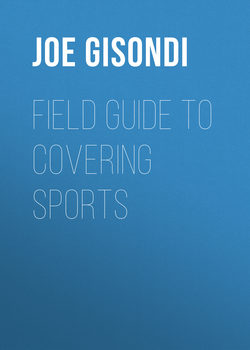Читать книгу Field Guide to Covering Sports - Joe Gisondi - Страница 40
На сайте Литреса книга снята с продажи.
Chapter 4 Developing and Writing Features
ОглавлениеResidents of a small Texas town are feeling uneasy about the high school girls basketball coach, a woman who turned a marginal program into one of the best teams in the state. She was named coach of the year several times and teacher of the year once. But the school board fired her. You’re a journalist, and you wonder why. People in town had praised her time and again. But you learn, all that happened before the coach moved in with another woman.
A young girl wants to be a boxer, but her dad fears for her safety. In a dirty, cramped gym in East Los Angeles, you walk near the ring where she’s training and notice she’s the only girl in the place. You smile at her dad and quietly take it all in. You can’t know then, but by hanging around for weeks, you’ll find out: Boxing is salvation for this preteen—and also for her father, a former gang member trying to get his own life in order.
A former National Football League superstar has withdrawn from society, skipping Super Bowl festivities (and pretty much everything else). He was among the toughest defensive backs ever to play the game; then, one day, he seemingly vanished. You learn that he lives in the remotest part of a remote Hawaiian island. You decide to spend several days with this former football star, a man whose toughness on and off the field is matched only by his desire for privacy.
As those stories—from Texas Monthly, the Los Angeles Times, and the South Florida Sun-Sentinel—show, sports journalism involves much more than writing about games. Sports reporters also write about individual athletes and coaches, teams, and schools and towns. They craft explanatory pieces about equipment and strategy and develop stories about overcoming obstacles. In the stories above, sports writers went beyond game coverage to find stories that extended outside the lines and the ropes.
Features and columns and all the other kinds of writing that go beyond “this happened on the field today” give writers a chance to explore new territory, develop a voice, and grab readers with the real drama of life. They also give you opportunities to try using multimedia elements to tell stories. (Check out the audio slideshow on boxer Seniesa Estrada, narrated by former Los Angeles Times writer Kurt Streeter.1)
Tips on feature writing could and in fact, do occupy shelves full of books. In this chapter, you’ll find the basics to get you started pursuing the stories that are all around you. When you’re new to journalism, it’s tempting to think that writing features must be way easier than covering news or games. Get over that idea. People will read a game story for the information, no matter how you write it. But nobody is required to read a feature. They’ll choose to read your stories only if you take them places and show them people and things they couldn’t reach on their own. (That’s almost literally true in the case of football player Jake Scott, who was tracked down by reporter Dave Hyde.)
There is no set way to write a sports feature, but finding a compelling story is a great way to start. Writing a sports feature is a lot like writing a fictional short story—except, of course, that journalists can’t make anything up. The elements, however—scene, setting, character, dialogue, description—are much the same.
Most stories can be boiled down to this: Someone wants something, but someone (or something) stands in the way. Conflict is the key to good storytelling. And the only way to get the facts, emotions, and intimate details you need to show people is through good, old-fashioned reporting.
Here’s something else to consider when developing stories: The best sports features are those that can be read by someone who doesn’t give a damn about sports. In many cases, the themes embedded in sports feature reflect controversial issues and topics that, through the prism of sports, people somehow feel more comfortable addressing, such as race, gender, health issues, abortion, and politics.
Let’s look first at some reporting issues related to developing and writing features. Then we’ll address storytelling techniques.
Digital Assist: Create A Facebook Page
Social media continues to expand, growing to include Facebook, YouTube, Twitter, Instagram, Pinterest, Snapchat, Linkedin, and Google+, among others. Facebook, though, remains a standard for news organizations, because from this platform you can easily promote your news organization by posting stories from websites and other social media, by breaking news that can feed directly to a Twitter feed, and by offering both breaking news or weekly chats through Facebook Live! Plus, you can publish stories directly through Notes that can include embedded links and photos. No other social media allows one to interact as well with readers, listeners, or viewers.
More than 2.1 million people follow USA Today’s “Sports” Facebook page. A few days before the 2017 NCAA basketball tournament, this page featured a two-minute video assessing the 68-team field, breaking news on a Nebraska high school football player charged with sexual assault, previews of tourney teams, and multiple stories published directly to the page as well as some that were promoted from the website and print editions.
USA Today sports also has 222,000 followers on Twitter, 45,000 on Instagram and 3,684 on its YouTube channel, but none have the impact of Facebook. Still, it’s important to create accounts on every social media channel to reach as many people as possible. Sports journalists need to know how to use social media to research, to report and to promote content. This is no longer an option.
